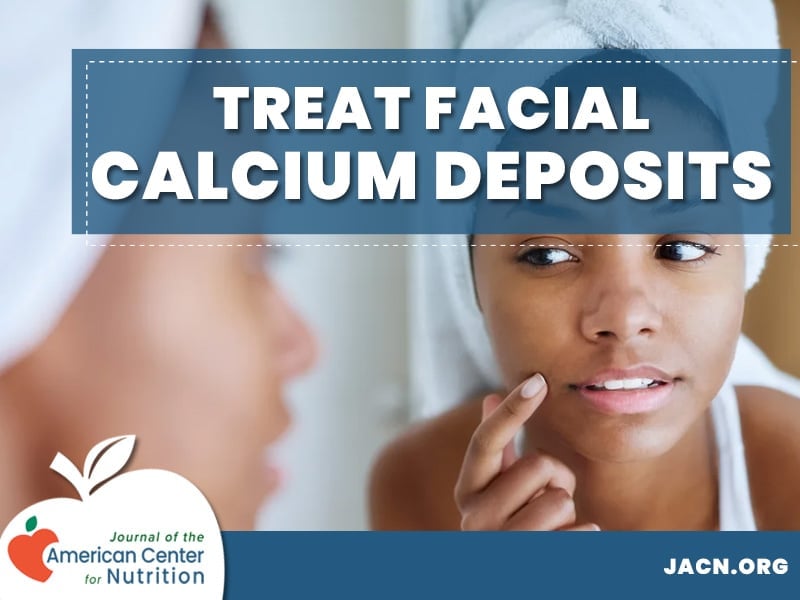Treatments for Calcium Deposits on the Face
Facial calcinosis cutis describes any condition marked by calcium deposits in the skin or subcutaneous tissue of the face. These deposits appear slowly on the skin as firm bumps that are white or yellow. Calcium deposits under the skin may appear on many parts of the body, but they may prove especially bothersome when they appear on the face.
Many causes of calcinosis cutis exist, including abnormal metabolism of calcium or phosphorus, damage to the skin, or as a result of an underlying condition [2]. Medical professionals treat calcium deposits using both natural and medication-based treatments, depending on the specific cause of the calcification.
Symptoms of Calcinosis Cutis of the Face
Someone suffering from calcinosis cutis experiences the growth of small, hard bumps on the skin, most commonly:
- On the fingertips
- Around the elbows
- Around the knees
- On the shins
- On the scrotum or labia
- On the face [1]
Facial calcinosis cutis occurs on the face, often on the cheeks and forehead. The bumps may appear in clusters and vary in size. One man diagnosed with facial calcinosis cutis secondary to acne vulgaris had papules that ranged from the size of a pinhead to five millimeters in diameter [3].
The skin bumps typically do not cause pain and may ooze a chalky white substance if punctured.

Medical professionals diagnose calcium deposits in the skin through various methods, including but not limited to:
- Blood counts
- Metabolic panels
- Hormone level testing
- Calcium and phosphorus level testing
- Arterial pH testing
- Biopsies
- X-rays, CTs, and MRIs
- Skin ultrasounds [1]
A biopsy of the deposit offers explicit confirmation of calcinosis cutis. This step can prove critical to avoid misdiagnosing calcification as acne, gouty tophi, and other skin conditions.
What Causes Calcium Deposits to Form on the Face?
Facial calcinosis cutis can be caused by several conditions, including facial tissue damage, underlying conditions like lupus or systemic sclerosis, and excessive calcium consumption. This last cause may occur when a person’s diet contains too much calcium, causing an excess within the body.
For example, if someone consumes or supplements an excessive amount of calcium, they may develop hypercalcemia. This can result in calcium deposits forming under the skin because the kidneys cannot absorb calcium effectively. Other nutrients that may cause facial calcinosis cutis include vitamin D and phosphorus.
A person struggling with calcinosis cutis should avoid eating foods high in calcium. This includes dietary supplements and antacids that contain calcium [1].
Types of Facial Calcium Deposits
Medical researchers have identified several types of calcinosis cutis, including:
Dystrophic Calcification
Dystrophic calcification occurs more often than any other type of calcinosis cutis, and it occurs as a result of dermal trauma or inflammation. When skin tissue sustains damage, the dying cells release phosphate-binding proteins, which inhibit calcium absorption and lead to calcification [1].
This type may appear following trauma, such as a heel-stick procedure in an infant, or as a result of an underlying connective tissue disease, most commonly dermatomyositis, systemic lupus erythematosus, or systemic sclerosis. Other conditions that may lead to dystrophic calcification include but are not limited to:
- Burns
- Basal cell carcinoma
- Cryptococcosis
- Histoplasmosis
- Pancreatic and lupus panniculitis
- Rheumatoid arthritis
- Scleroderma
- Sjogren syndrome
- Trichilemmal cyst
- Werner syndrome [1]
- Acne vulgaris [3]
Some sufferers of dystrophic calcinosis cutis experience ulceration of the calcium deposits, where a chalky white substance oozes from the skin lesions [2].
Iatrogenic Calcification
Iatrogenic calcinosis cutis occurs following specific medical treatments. For example, patients receiving intravenous calcium chloride, calcium gluconate, or para-aminosalicylic acid may develop calcium deposits in the skin, especially around the IV site. Calcium salts may also appear on the skin following the application of an electrode paste containing calcium chloride, which doctors use for electroencephalography (EEG) and other imaging methods [1].
Doctors can prevent iatrogenic calcification by administering diluted calcium solutions to patients and ensuring that they don’t have elevated phosphate levels [1]. Iatrogenic calcification lesions tend to disappear within four to six months [2].
Metastatic Calcification
While the two types of calcium deposits above do not relate to mineral metabolism, metastatic calcinosis cutis occurs because the body is not metabolizing calcium or phosphorus properly. For example, the person may suffer from chronic renal failure or have milk-alkali syndrome, a condition characterized by excessive calcium in the body due to over-supplementation or another dietary cause [2].
Other medical conditions that may lead to metastatic calcification include but are not limited to:
- Hypervitaminosis D
- Hyperparathyroidism
- Malignant neoplasms
- Sarcoidosis [1]
In these cases, medical professionals treat the underlying disease to relieve patients’ calcinosis cutis symptoms.
Idiopathic Calcification
Doctors diagnose idiopathic calcinosis cutis when the patient presents symptoms without abnormal calcium or phosphorus levels and with no tissue damage. This type most commonly appears on the genitalia, face, and around major joints. For example, a child may develop subepidermal nodules on the head or extremities, and an adult may develop intramuscular calcification around the knees [1,2].
Best Methods for Getting Rid of Facial Calcium Deposits
A physician may treat facial calcinosis cutis using a variety of methods, depending on the type and cause. For example, if an underlying condition results in calcification, treating the disease may result in the deposits going away on their own. A doctor may also prescribe certain medications or surgically remove the calcium deposits.
No standardized treatment currently exists for calcinosis cutis, but medications previously used to successfully treat this condition include but are not limited to:
- Antiinflammatories
- Bisphosphonates
- Ceftriaxone
- Colchicine
- Corticosteroids
- Diltiazem
- Intravenous immunoglobulin
- Minocycline
- Thalidomide
- TNF inhibitors
- Topical sodium thiosulfate
- Warfarin [2,4]
Natural Treatments for Calcium Deposits on the Face
In addition to medical intervention, sufferers can take a natural approach to treatment. Natural treatment methods for facial calcium deposits include:
Diet
A diet low in calcium and phosphorus may help reduce symptoms of calcinosis cutis. This natural method offers limited effectiveness, depending on the underlying cause of the calcification. People with severe cases may not experience relief from symptoms [2].
Dietary changes for reducing levels of calcium in the body include:
- Drinking more water
- Avoiding antacids containing calcium
- Ceasing calcium supplementation
- Limited consumption of milk, cheese, pudding, yogurt, and ice cream
- Avoiding calcium-fortified foods [5]
Hydration proves especially important for reducing symptoms of many conditions.
Apple Cider Vinegar
Although effects in humans require further investigation, a study in rats found that consuming vinegar improved calcium absorption in the intestines. Anecdotal evidence suggests that people struggling with calcification should drink apple cider vinegar (one tablespoon with a glass of water) on a daily basis to help calcium deposits break down and absorb into the body [6].
Chanca Piedra
Another anecdotal solution comes from chanca piedra, a plant known for its benefits in breaking down kidney stones. Studies support its effectiveness in treating urinary calculi, but more research is needed to confirm its usefulness for sufferers of calcinosis cutis.
Conclusion
Facial calcinosis cutis can cause pain and discomfort and impact self-esteem. Anyone dealing with these firm, white or yellow bumps on the face is encouraged to speak with their doctor to determine if they have an underlying condition or abnormal calcium metabolism. A medical professional can confirm a calcinosis cutis diagnosis and recommend the best treatment, including eating a balanced diet and limiting calcium-rich foods and supplements.
REFERENCES
- https://www.ncbi.nlm.nih.gov/books/NBK448127/
- https://www.sciencedirect.com/topics/medicine-and-dentistry/calcinosis-cutis
- https://www.ncbi.nlm.nih.gov/pmc/articles/PMC4738514/
- https://pubmed.ncbi.nlm.nih.gov/21679811/
- https://www.saintlukeskc.org/health-library/discharge-instructions-hypercalcemia
- https://www.jstage.jst.go.jp/article/bbb/63/5/63_5_905/_article
- https://www.ncbi.nlm.nih.gov/pmc/articles/PMC6092661/

